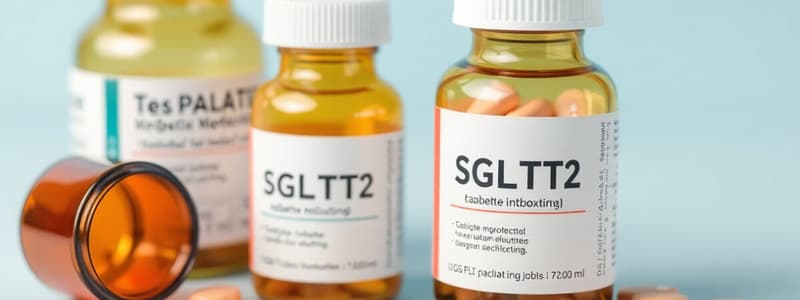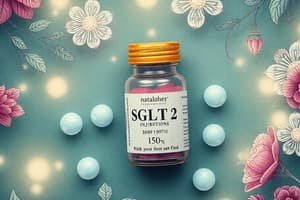Podcast
Questions and Answers
A patient with type 2 diabetes is prescribed a medication that enhances insulin sensitivity in muscle, fat, and liver cells. Which class of medication is the patient most likely taking?
A patient with type 2 diabetes is prescribed a medication that enhances insulin sensitivity in muscle, fat, and liver cells. Which class of medication is the patient most likely taking?
- Sulfonylureas
- Insulin Analogs
- Thiazolidinediones (correct)
- DPP-4 inhibitors
A patient is prescribed a medication that stimulates insulin secretion from pancreatic beta cells. Which class of medication is the patient most likely taking?
A patient is prescribed a medication that stimulates insulin secretion from pancreatic beta cells. Which class of medication is the patient most likely taking?
- Thiazolidinediones
- DPP-4 inhibitors
- Insulin Analogs
- Sulfonylureas (correct)
Which class of medication is known to slow gastric emptying and cause weight loss?
Which class of medication is known to slow gastric emptying and cause weight loss?
- Thiazolidinediones
- DPP-4 inhibitors
- Tirzepatide (correct)
- Sulfonylureas
Which class of diabetes medication increases glucose-dependent insulin release?
Which class of diabetes medication increases glucose-dependent insulin release?
A patient taking a diabetes medication experiences increased peripheral glucose uptake. Which medication class are they most likely taking?
A patient taking a diabetes medication experiences increased peripheral glucose uptake. Which medication class are they most likely taking?
Which of the following diabetes medications is administered via subcutaneous injection (SQ)?
Which of the following diabetes medications is administered via subcutaneous injection (SQ)?
Which medication class for diabetes is associated with weight gain as a potential side effect?
Which medication class for diabetes is associated with weight gain as a potential side effect?
A doctor would like to prescribe an oral medication to manage a patient's diabetes. Which of the following medications would be appropriate?
A doctor would like to prescribe an oral medication to manage a patient's diabetes. Which of the following medications would be appropriate?
A patient with type 2 diabetes is obese and requires a medication that will minimize the risk of hypoglycemia while also promoting weight loss. Which of the following drug classes would be MOST appropriate?
A patient with type 2 diabetes is obese and requires a medication that will minimize the risk of hypoglycemia while also promoting weight loss. Which of the following drug classes would be MOST appropriate?
Which of the following mechanisms of action is shared by both GLP-1 receptor agonists and GLP-1/GIP receptor agonists?
Which of the following mechanisms of action is shared by both GLP-1 receptor agonists and GLP-1/GIP receptor agonists?
A patient newly diagnosed with type 2 diabetes is prescribed metformin. What is the PRIMARY mechanism by which metformin lowers blood glucose?
A patient newly diagnosed with type 2 diabetes is prescribed metformin. What is the PRIMARY mechanism by which metformin lowers blood glucose?
Which class of T2DM medications is MOST likely to cause weight loss?
Which class of T2DM medications is MOST likely to cause weight loss?
A patient is taking a medication that increases urinary glucose excretion. Which class of medication are they MOST likely taking?
A patient is taking a medication that increases urinary glucose excretion. Which class of medication are they MOST likely taking?
Which of the following drug classes for type 2 diabetes acts by increasing glucose-dependent insulin release?
Which of the following drug classes for type 2 diabetes acts by increasing glucose-dependent insulin release?
A patient with type 2 diabetes is already taking metformin and needs additional glycemic control. Which of the following medications would be LEAST likely to cause hypoglycemia when added to their regimen?
A patient with type 2 diabetes is already taking metformin and needs additional glycemic control. Which of the following medications would be LEAST likely to cause hypoglycemia when added to their regimen?
Which route of administration is associated with all of the following T2DM drug classes: Biguanides and SGLT2 inhibitors?
Which route of administration is associated with all of the following T2DM drug classes: Biguanides and SGLT2 inhibitors?
Flashcards
Biguanides (Metformin)
Biguanides (Metformin)
Reduces glucose production in the liver and improves the body's sensitivity to insulin.
SGLT2 Inhibitors
SGLT2 Inhibitors
Enhances the excretion of glucose through urine, lowering blood sugar levels.
GLP-1 Receptor Agonists
GLP-1 Receptor Agonists
Simulates insulin release based on blood glucose levels, reduces glucagon, and slows digestion.
GLP-1/GIP Receptor Agonists
GLP-1/GIP Receptor Agonists
Signup and view all the flashcards
Weight Effect of Metformin
Weight Effect of Metformin
Signup and view all the flashcards
Weight Effect of SGLT2 Inhibitors
Weight Effect of SGLT2 Inhibitors
Signup and view all the flashcards
Weight Effect of GLP-1 Receptor Agonists
Weight Effect of GLP-1 Receptor Agonists
Signup and view all the flashcards
Weight Effect of GLP-1/GIP Receptor Agonists
Weight Effect of GLP-1/GIP Receptor Agonists
Signup and view all the flashcards
Tirzepatide
Tirzepatide
Signup and view all the flashcards
DPP-4 Inhibitors
DPP-4 Inhibitors
Signup and view all the flashcards
Thiazolidinediones
Thiazolidinediones
Signup and view all the flashcards
Sulfonylureas
Sulfonylureas
Signup and view all the flashcards
Insulin Analogs
Insulin Analogs
Signup and view all the flashcards
Human Insulin
Human Insulin
Signup and view all the flashcards
Weight and Tirzepatide
Weight and Tirzepatide
Signup and view all the flashcards
Weight and Thiazolidinediones
Weight and Thiazolidinediones
Signup and view all the flashcards
Study Notes
- Type 2 Diabetes drugs comparison
Biguanides (metformin)
- Decreases hepatic production of glucose and increases insulin sensitivity.
- Administered orally.
- A1C lowering is moderate.
- Hypoglycemia risk is absent.
- There is potential for weight loss.
- Cost is low.
SGLT2 inhibitors
- Increases urinary glucose excretion.
- Administered orally.
- A1C lowering is moderate.
- Hypoglycemia risk is absent.
- Causes weight loss.
- Cost is high.
GLP-1 receptor agonists
- Increases glucose-dependent insulin release, decreases glucagon secretion, and slows gastric emptying.
- Administered subcutaneously or orally.
- A1C lowering is high
- Hypoglycemia risk is absent.
- Causes weight loss.
- Cost is very high.
- Dulaglutide and subcutaneous semaglutide have greater A1C-lowering efficacy and weight loss effects than other GLP-1 receptor agonists.
GLP-1/GIP receptor agonists (e.g., tirzepatide)
- Increases glucose-dependent insulin release, decreases glucagon secretion, and slows gastric emptying.
- Administered via subcutaneous injection.
- A1C lowering is very high
- Hypoglycemia risk is absent.
- Causes weight loss.
- Cost is very high.
DPP-4 inhibitors
- Increases glucose-dependent insulin release and decreases glucagon secretion.
- Administered orally.
- A1C lowering is low.
- Hypoglycemia risk is absent.
- Has a neutral effect on weight.
- Cost is high.
Thiazolidinediones
- Increases insulin sensitivity in muscle, fat, and liver cells and increases glucose entry into cells.
- Administered orally.
- A1C lowering is moderate.
- Hypoglycemia risk is absent.
- Causes weight gain.
- Cost is low.
- Pioglitazone is generic and has low cost, however, rosiglitazone is currently unavailable in the U.S.
Sulfonylureas
- Stimulates insulin secretion from pancreatic beta cells.
- Administered orally.
- A1C lowering is moderate.
- Hypoglycemia risk is present.
- Causes weight gain.
- Cost is low.
Insulin Analogs
- Stimulates peripheral glucose uptake by skeletal muscle and fat tissue, inhibits hepatic glucose production
- Administered via subcutaneous injection.
- A1C lowering is high
- Hypoglycemia risk is present.
- Causes significant weight gain.
- Cost is high.
Human Insulin
- Stimulates peripheral glucose uptake by skeletal muscle and fat tissue, inhibits hepatic glucose production
- Administered subcutaneously or via inhalation.
- A1C lowering varies; it must be titrated to response.
- Hypoglycemia risk is present.
- Causes weight gain.
- Cost is low.
Notes
- The extent of A1C lowering and weight change is highly variable based upon factors including but not limited to baseline A1C, baseline weight, patient-specific characteristics, lifestyle modifications, and whether monotherapy or a multi-drug regimen is being utilized.
Studying That Suits You
Use AI to generate personalized quizzes and flashcards to suit your learning preferences.





